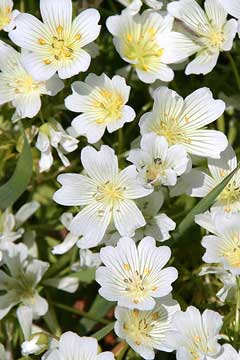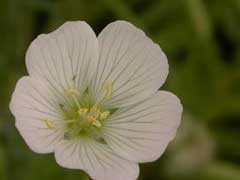 |
|
http://www.flickr.com/photos/lance_mountain/ |
 |
|
Translate this page:
Summary
Physical Characteristics

 Limnanthes alba is a ANNUAL growing to 0.2 m (0ft 8in). It is in flower from May to June. The species is hermaphrodite (has both male and female organs) and is pollinated by Bees.
Limnanthes alba is a ANNUAL growing to 0.2 m (0ft 8in). It is in flower from May to June. The species is hermaphrodite (has both male and female organs) and is pollinated by Bees.
It is noted for attracting wildlife.
Suitable for: light (sandy), medium (loamy) and heavy (clay) soils and prefers well-drained soil. Suitable pH: mildly acid, neutral and basic (mildly alkaline) soils. It cannot grow in the shade. It prefers moist soil.
UK Hardiness Map
US Hardiness Map
Synonyms
L. douglasii alba.
Plant Habitats
Cultivated Beds;
Edible Uses
Edible Parts: Oil
Edible Uses: Oil
None known
References More on Edible Uses
Medicinal Uses
Plants For A Future can not take any responsibility for any adverse effects from the use of plants. Always seek advice from a professional before using a plant medicinally.
None known
References More on Medicinal Uses
The Bookshop: Edible Plant Books
Our Latest books on Perennial Plants For Food Forests and Permaculture Gardens in paperback or digital formats.

Edible Tropical Plants
Food Forest Plants for Hotter Conditions: 250+ Plants For Tropical Food Forests & Permaculture Gardens.
More

Edible Temperate Plants
Plants for Your Food Forest: 500 Plants for Temperate Food Forests & Permaculture Gardens.
More

More Books
PFAF have eight books available in paperback and digital formats. Browse the shop for more information.
Shop Now
Other Uses
Oil
An oil obtained from the seed has similar properties to whale sperm oil and to Jojoba (Simmondsia chinensis). It has specialized industrial applications[141]. The seed contains ca 20% protein, 25 - 30% oil, with 1.56% volatile isothiocyanates. The high concentration of C20 and fatty acids in the seed oil is unique. No other seed oil is known to have as high concentration (>90%) of total fatty acids of chain length greater than C18[269].
Special Uses
Attracts Wildlife
References More on Other Uses
Cultivation details
Succeeds in any soil[1]. Prefers an open sunny position and a cool root run, doing well by concrete paths, rocks etc. Ranging from Warm Temperate Moist through Subtropical Dry to Moist Forest Life Zones, white foam, or cvs thereof, is reported to tolerate annual precipitation of 70 to 11 m, an annual temperature of 12 to 19°C, and pH of 5.6 to 6[269]. This species is essentially a xerophyte, flowering and setting seed on the last seasonal soil and stem moisture. It has about the same water requirement as dry-farmed winter grains, and seems to require less moisture than other species of this genus. Does well on soils with pH 6.2, especially on slopes and in cultivated fields[269]. The seed contains about 24 - 30% of an oil that is potentially a good replacement for sperm whale oil. This species is being trialled as a possible commercial oil seed crop[269]. The sub-species L. alba versicolor has slightly higher oil yields, around 31%[269]. Experimentally, yields of 1 tonne of seed per hectare has been obtained, though these yields would need to be doubled to make the plant a commercial prospect[269]. Some new cultivars have been developed with better seed retention and higher oil yields[269]. A very good bee and hoverfly plant.
References Carbon Farming Information and Carbon Sequestration Information
Temperature Converter
Type a value in the Celsius field to convert the value to Fahrenheit:
Fahrenheit:
The PFAF Bookshop
Plants For A Future have a number of books available in paperback and digital form. Book titles include Edible Plants, Edible Perennials, Edible Trees,Edible Shrubs, Woodland Gardening, and Temperate Food Forest Plants. Our new book is Food Forest Plants For Hotter Conditions (Tropical and Sub-Tropical).
Shop Now
Plant Propagation
Seed - sow spring or autumn in situ. Germination takes place within 3 weeks. Germination is better at lower temperatures - good results are achieved at about 5°C, whilst temperatures in excess of 20°C give poor results[269].
Other Names
If available other names are mentioned here
Native Range
NORTHERN AMERICA: United States (California (north-central))
Weed Potential
Right plant wrong place. We are currently updating this section.
Please note that a plant may be invasive in one area but may not in your area so it's worth checking.
Conservation Status
IUCN Red List of Threatened Plants Status :

Growth: S = slow M = medium F = fast. Soil: L = light (sandy) M = medium H = heavy (clay). pH: A = acid N = neutral B = basic (alkaline). Shade: F = full shade S = semi-shade N = no shade. Moisture: D = dry M = Moist We = wet Wa = water.
Now available:
Food Forest Plants for Mediterranean Conditions
350+ Perennial Plants For Mediterranean and Drier Food Forests and Permaculture Gardens.
[Paperback and eBook]
This is the third in Plants For A Future's series of plant guides for food forests tailored to
specific climate zones. Following volumes on temperate and tropical ecosystems, this book focuses
on species suited to Mediterranean conditions—regions with hot, dry summers and cool, wet winters,
often facing the added challenge of climate change.
Read More
Expert comment
Author
Hartw. ex Benth.
Botanical References
171
Links / References
For a list of references used on this page please go here
Readers comment
© 2010, Plants For A Future. Plants For A Future is a charitable company limited by guarantee, registered in England and Wales. Charity No. 1057719, Company No. 3204567.